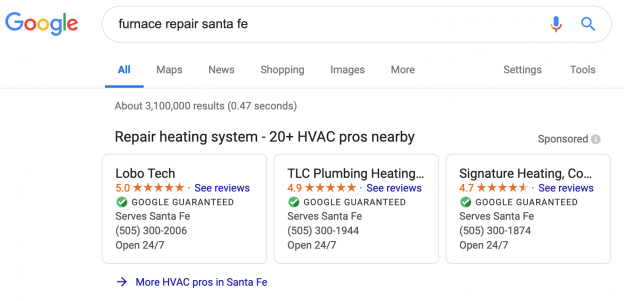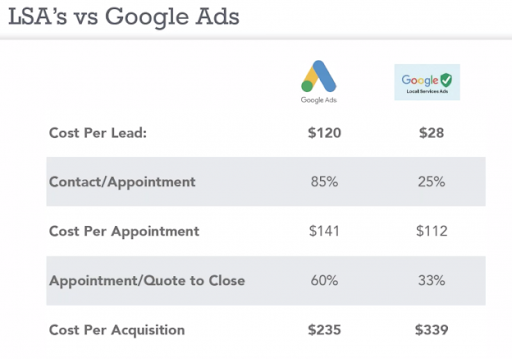
It has been two years since the rollout of Google’s Local Services Ads (LSAs), and we have been able to keep an eye on how this paid search product is playing out for the home performance and HVAC industries.
What have we learned about LSAs since 2018? We had a few predictions from our last LSA check-in in April of 2019, and they seemed to have panned out as we expected:
As LSAs have become universally available, lead quality and volume have continued to decline.
LSAs as a primary lead generating tactic can be a crutch to other paid search performance, and are not recommended to take precedence over other digital marketing efforts.
The What and Where of Local Service Ads in 2020
LSAs are still a paid product that shows up in the prime spot of search engine result pages (SERPs). It affects most HVAC and home performance categories — so when someone searches for a service in a city where LSAs are available (e.g., “furnace repair in Santa Fe NM”) the searcher is given a carousel list of three contractors (if searching on a desktop) with their contact info, a “Google Guarantee” badge, and their cumulative Google review status. It looks like this:

LSAs are the first thing a searcher, or potential lead, will see in an area where the ads are available. This prime real estate is why you pay for a service like LSAs.
LSAs are still at the very tippy-top, above all other organic results, the Local Pack, and any other Pay Per Click ads (PPC). There is still a “Google Guarantee” badge which displays within the LSA format (and we still believe that your own company or brand’s guarantee is probably much better.) And lastly, LSAs are still occupying only three spots, and those three spots are ranked based on the following:
-
Location (There’s not much to be done here; it is what it is)
-
Review score (This includes all reviews, but especially those from customers who reviewed your business after finding you through an LSA)
-
GMB responsiveness
-
Business hours
-
Any existing complaints to Google about your business
Categories have expanded to include thermostat installation (which we can assume is a byproduct of Google’s relationship with Nest — search volume for “Nest Thermostat installation” is over 87x that of just “thermostat installation service.”) All leads that come in through LSAs are managed through an app. When a lead comes in, you get a phone number, the category they searched for, if that lead click has been charged to your account, and sometimes (we’re not sure what determines this) the service they are looking for. You will not receive a name for any of your LSA leads.
How LSAs Have Changed Over Time
Google began testing LSAs in 2016, and we started seeing the rollout in 2018. Now that they have been operating for nearly a year, not much has changed as far as the look and feel of LSAs. What has changed and evolved is how widespread they now are, as well as how we recommend you use them.
Initially, the primo real estate that these ads took up showed potential to be a game changer for paid search ads. A lot of HVAC service providers we work with at Energy Circle were both excited and anxious to get in early and capture as much paid local search as possible. However, the quality of these leads and their related lead economics aren’t having much of a blockbuster effect anymore, and it seems the honeymoon is over.
LSAs Devour PPC
This is a textbook example of how Google has set themselves up to win. LSAs have pushed Google Ads (PPC ads) further down the page — sometimes they appear between the local pack and LSAs, sometimes they are pushed down below both — but this just means Google now has two products for searchers to sift through before any organic results. LSAs are having a continued effect on impressions and clicks, as expected:
6 Months: New LSA Market
-
Impressions are down 44%
-
Clicks are down 67%
-
Average CPC is up 3%
12 Months: Mature LSA Market
-
Impressions are down 59%
-
Clicks are down 62%
-
Average CPC is up 18%
24 Months: The LSA Market Today
Cost Per Lead
The cost per lead has averaged out to be $28 for the HVAC industry. From what we are hearing, the chance that you will actually talk to a customer who has submitted a lead is around 25%. So the “real” cost per qualified lead is about $112.
From those qualified leads, we are seeing a close rate of 33%. So, when you follow the money all the way through to a completed job, each LSA acquisition is costing $339. Of course, whether or not these numbers will work for you will depend on your business; but if we use the 7% Customer Acquisition Cost rule of thumb, you will need to be booking jobs with an invoiced value of $4,843.
When compared to Google Ads, we are seeing that a solid PPC strategy is providing higher quality leads as well as higher contact/appointment rates:

The higher contact/appointment rate of Google Ads could be an indicator that LSAs are not producing the qualified leads we were expecting this time last year.
Utilizing LSAs To Supplement Other Tactics
As we predicted, based on what we are seeing with our clients (and incoming clients that have been previously pushing their LSA game hard) LSAs are not a replacement for other digital marketing tactics. One reason: there is no way to optimize your LSA performance within the product itself — you place your bets and let it ride.
With just about every other digital marketing tactic available, you will be able to test, tweak, and optimize your budget, messaging, and, in some cases, design, to maximize your online visibility and lead generation. This is not to say they can’t be useful when integrated with a comprehensive digital marketing strategy — but we still recommend you don’t put all of your weight behind LSAs, and stick with other proven tactics that provide more control.